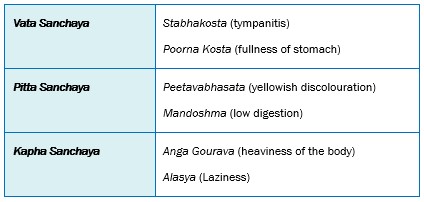Kriyakala in Ayurveda: Understanding disease progression for precise treatments
DOI:
https://doi.org/10.21760/jaims.9.1.14Keywords:
Dosha, Dhatu, Mala, Shat Kriyakala, AyurvedaAbstract
Ayurveda, an ancient wisdom, focuses on keeping healthy people healthy and healing those who are unwell. It does this by balancing Dosha (biological factors), Dhatu (body tissues), and Mala (waste). Shat Kriyakala is about understanding how a disease progresses. It helps figure out the right actions to fix dosha imbalances. Kriyakala is a mix of two words: Kriya, meaning the treatments like medicine, food, and habits that help fix dosha imbalances, and Kala, which shows the stage of a disease. Acharya Sushruta talked about six stages that tell us how a disease is developing in the body. This guides us on when to step in with treatment. Detecting diseases early means we can treat them more effectively and with less discomfort. This study aims to show how Shat Kriyakala is super useful in figuring out how diseases progress and how severe they might get. This concept is found in ancient texts. Kriyakala is like a guidebook. It tells us about diagnosis (figuring out what's wrong), prognosis (how the disease might go), and when to act. This helps prevent a disease from taking a strong hold in the body. Understanding Kriyakala helps us know when to step in to keep diseases from getting worse.
Downloads
References
Acharya JT. Charaka Samhita with Ayurveda Dipika commentary of Chakrapani Datta. Reprint ed. Varanasi (India): Chaukhambha Orientalia; 2011. p. 98.
Astang hrdaya of Vagbhat, Prof. Banwari Lal Gaur, Editor reprint 2013, Chaukhambha Orientalia Varanasi; 2013, P.215.
Sushrut. Shushrut samhita, Ambika dutta shastri, Editor reprint 2008. Chaukhambha Sanskrit Sansthan Varanasi; 2008; P.64
Sushrut. Shushrut Samhita, Ambika dutta shastri, Editor reprint 2008. Chaukhambha Sanskrit Sansthan Varanasi; 2008; P.60.
Sushrut. Shushrut Samhita, Ambika dutta shastri, Editor reprint 2008. Chaukhambha Sanskrit Sansthan Varanasi; 2008; P.62.
Sarth Vagbhat, Ganesh Krushna Garde, Editor reprint 2012, Prophishant Publishing House Pune; 2012; P.64.
Sushrut. Shushrut Samhita, Ambika dutta shastri, Editor reprint 2008. Chaukhambha Sanskrit Sansthan Varanasi; 2008; P.63.
Ayurvediya Vikrti Vijnana and Roga Vijnana, Dr.P.S.Byadgi, Editor reprint 2011. Chaukhambha Sanskrit Sansthan Varanasi; 2011; P.122.
Sushrut. Shushrut Samhita, Ambika dutta shastri, Editor reprint 2008. Chaukhambha Sanskrit Sansthan Varanasi; 2008; P.63.
Sushrut. Shushrut Samhita, Ambika dutta shastri, Editor reprint 2008. Chaukhambha Sanskrit Sansthan Varanasi; 2008; P.63.
Sushrut. Shushrut Samhita, Ambika dutta shastri, Editor reprint 2008. Chaukhambha Sanskrit Sansthan Varanasi; 2008; P.63.















